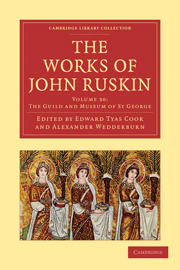Book contents
- Frontmatter
- Contents
- LIST OF ILLUSTRATIONS
- INTRODUCTION TO THIS VOLUME
- PART I THE GUILD OF ST. GEORGE
- I ABSTRACT OF THE OBJECTS AND CONSTITUTION OF ST. GEORGE'S GUILD (1877), WITH THE MEMORANDUM OF ASSOCIATION (1878)
- II THE MASTER'S REPORT (1879)
- III THE MASTER'S REPORT (1881)
- IV GENERAL STATEMENT EXPLAINING THE NATURE AND PURPOSES OF ST. GEORGE'S GUILD (1882)
- V THE MASTER'S REPORT (1884)
- VI THE MASTER'S REPORT (1885)
- VII ACCOUNTS OF THE ST. GEORGE'S GUILD, 1871–1882 (1884)
- VIII ACCOUNTS OF ST. GEORGE'S GUILD, 1881–1883 (1884)
- IX ACCOUNTS OF ST. GEORGE'S GUILD, 1884 (1885)
- X ADDITIONAL PASSAGES RELATING TO ST. GEORGE'S GUILD
- PART II THE ST. GEORGE'S MUSEUM
- APPENDIX
- Plate section
IV - GENERAL STATEMENT EXPLAINING THE NATURE AND PURPOSES OF ST. GEORGE'S GUILD (1882)
Published online by Cambridge University Press: 07 September 2011
- Frontmatter
- Contents
- LIST OF ILLUSTRATIONS
- INTRODUCTION TO THIS VOLUME
- PART I THE GUILD OF ST. GEORGE
- I ABSTRACT OF THE OBJECTS AND CONSTITUTION OF ST. GEORGE'S GUILD (1877), WITH THE MEMORANDUM OF ASSOCIATION (1878)
- II THE MASTER'S REPORT (1879)
- III THE MASTER'S REPORT (1881)
- IV GENERAL STATEMENT EXPLAINING THE NATURE AND PURPOSES OF ST. GEORGE'S GUILD (1882)
- V THE MASTER'S REPORT (1884)
- VI THE MASTER'S REPORT (1885)
- VII ACCOUNTS OF THE ST. GEORGE'S GUILD, 1871–1882 (1884)
- VIII ACCOUNTS OF ST. GEORGE'S GUILD, 1881–1883 (1884)
- IX ACCOUNTS OF ST. GEORGE'S GUILD, 1884 (1885)
- X ADDITIONAL PASSAGES RELATING TO ST. GEORGE'S GUILD
- PART II THE ST. GEORGE'S MUSEUM
- APPENDIX
- Plate section
Summary
1. This Guild was originally founded with the intention of showing how much food-producing land might be recovered by well-applied labour from the barren or neglected districts of nominally cultivated countries. With this primary aim, two ultimate objects of wider range were connected: the leading one, to show what tone and degree of refined education could be given to persons maintaining themselves by agricultural labour; and the last, to convince some portion of the upper classes of society that such occupation was more honourable, and consistent with higher thoughts and nobler pleasures, than their at present favourite profession of war; and that the course of social movements must ultimately compel many to adopt it,—if willingly, then happily, both for themselves and their dependants,—if resistingly, through much distress, and disturbance of all healthy relations between the master and paid labourer.
2. But I had myself in early life known so many good and wise soldiers, and had observed so constantly in my historical readings the beneficence of strict military order in peace, and the justice, sense, and kindness of good officers acting unrestrictedly in civil capacities, that I looked first to the army itself for help in exemplifying the good to be looked for from a change in its functions; and wrote, in the first developed statement of the design of St. George's Guild (Fors, Letter 37, January 1874, p. II), that its Commandants were to be veteran soldiers.
- Type
- Chapter
- Information
- The Works of John Ruskin , pp. 43 - 66Publisher: Cambridge University PressPrint publication year: 2010First published in: 1907



